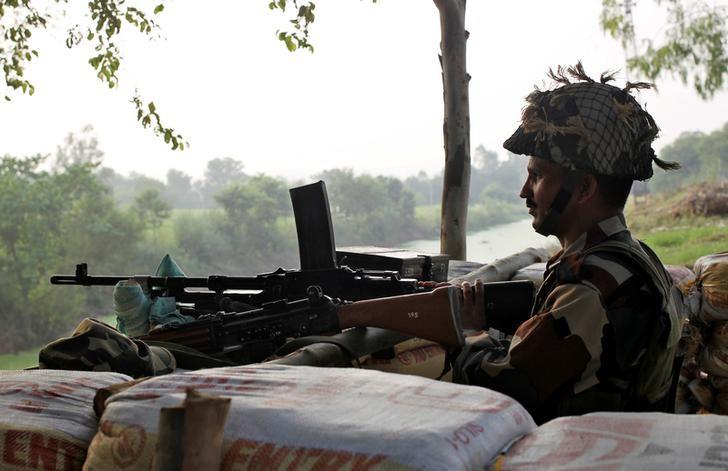India's Russian Deals To Build Assault Rifles and Light Utility Helicopters in Jeopardy
India’s two much-hyped joint ventures (JVs) with Russia are floundering over costs, flawed planning and overreach on achieving 'atmanirbharta' in the military sector.
Chandigarh: India’s two much-hyped joint ventures (JVs) with Russia to licence-build assault rifles and light utility helicopters (LUH) are floundering over costs, flawed planning and overreach on achieving
atmanirbharta or domestic self-sufficiency in the military sector.
Industry officials said the collaborative Indo-Russian Private Limited (IRPL) to supply India’s military 750,000
Kalashnikov Ak-203 rifles and India-Russia Helicopters (IRHL) established to
deliver 200 Kamov Ka-226T ‘Hoodlum’ LUHs to the Indian Air Force (IAF) and the Army Aviation Corps (AAC) stand jeopardised for broadly analogous reasons.
Both the rifles and the LUHs are badly-needed to fill operational voids, presently being managed either through emergency imports, or via creative
jugaad or innovation, at a time when all three services, especially the Indian Army, faces enduring challenges in a volatile neighbourhood. The requirement for LUHs is even more dire, as they are badly-needed to replace the IAF’s and the AACs obsolete and accident-prone licence-built Chetak (Aerospatiale Alouette III) and Cheetah (Aerospatiale SA-315B) helicopters dating back to the mid-1960s.
“The responsibility for these continuing setbacks lies equally with the services for their flawed planning and the Ministry of Defence (MoD) for its rigid and byzantine procedures that few can comprehend and even fewer implement” admitted a former defence ministry official. Instead of following a practical and realistic approach to military capability development, the services and the MoD are forever engaged in a tussle that obviates its attainment he added, declining to be identified as he was fearful of repercussions, despite having retired.
The Ak-203 saga began after the Army’s wholly impractical multi-calibre assault rifle tender was eventually terminated in 2015 after five fruitless years of trials and evaluations following a flawed qualitative requirement (QR) formulated by the Infantry Directorate for the weapon system. The proposed rifles were intended to replace the indigenously developed Indian Small Arms System (INSAS) 5.56x45mm assault rifles that entered IA service in the mid-1990s, but were seriously flawed and ultimately declared ‘operationally’ inadequate by the force in 2010.
After the disastrous multi-calibre procurement was rescinded the Army, yet again amazingly re-ignited deliberations over which calibre rifle – 5.56mm or 7.62mm – it operationally required. Its ponderings were interspersed with attempts to source an assault rifle from the state-run Ordnance Factory Board (OFB), however, failed. But four years later, in March 2019, just ahead of the general elections a few weeks later, Prime Minister Narendra Modi inaugurated an OFB facility at Korwa near Amethi to licence build 750,000 Russian Kalashnikov Ak-203 7.62x39mm assault rifles with collapsible stocks.
The JV to implement the project followed an Inter-Governmental Agreement (IGA) that was signed soon after in which the OFB had a 50.5% stake in IRPL, the Kalashnikov Group 42% and Russia’s state-owned arms export agency Rosonboronexport, the remaining 7.5%.
The intent was for IRPL to import some 100,000 AK-203’s for around $ 1,100 (Rs 81,000) apiece to meet the army’s urgent operational needs, followed by the licensed production of the remaining 650,000-odd units. Almost immediately, un-reconcilable price differences and technology transfer issues emerged, which industry sources said could not be resolved even during defence minister Rajnath Singh’s recent Moscow visit in September. This, in turn, led to the MoD instituting a ‘Costing Committee’ in September to try and resolve the ‘unreasonable and unacceptable’ rifle contract price reportedly being demanded by Russia. For now, it’s not clear whether this committee’s report has been submitted to the MoD, and if so, what has been the outcome. But the reality is that the Ak-203 deal remains unsigned and the bulk of the IA continues to operate the inefficient INSAS rifles while frontline units employed on counter-insurgency operations (COIN) are dependent on imported weapons.
The Russians were also reportedly demanding a royalty of $200 per Ak-203 rifle produced by the JV, making it an astronomical licence fee of $130 million for 650,000 units, in addition to the cost of erecting the plant, the bulk of which would be borne by OFB. The JV is expected to annually produce 70,000 Ak-203’s, initially from knocked-down kits and later by localising components and sub-assemblies to indigenise production to further the governments Atmanirbhar Bharat initiative.
But contractual problems did not end here.
The OFB is believed to have costed each licence-built Ak-203 rifle initially at around Rs 86,000, amortised over time to average around Rs 80,000 per unit. Embarrassingly, in comparison the import of a repeat import order for 72,400 assault rifles from the US-based Sig Sauer in early 2019 and late 2020, to meet the IA’s urgent operational needs, was considerably cheaper.
Official sources revealed that Sig Sauer’s SIG716 rifle priced at $990 (Rs 72,782) each in 2018 had emerged as L1 or lowest bidder in response to the IA’s tender, besting rivals Israel Weapon Industries and Abu Dhabi’s Caracal International that quoted $1600 and $2000 for their ACE-1 and CAR 817 assault rifles respectively. This was between Rs 13,218 and Rs 7,218 cheaper than that projected by the OFB for each Ak-203 that was really a derivative of the original Ak-47 dating back to 1947.
The obvious price differential which, when extrapolated over 650,000 rifles led to concern and raised eyebrows amongst cautious MoD officials, fearful of adverse publicity if they signed off on the inequitable rifle deal, despite government eagerness to do so to further atmanirbharta.
Cost disparity in LUH JV also
Meanwhile, the Ka-226T LUH deal that was initially announced during Russian President Vladimir Putin’s visit to India in December 2014, following which the IRHL JV was later formed, too awaits closure. This included the direct import of 60 LUHs, assembling 40 and building an additional 100 platforms, in which the indigenous content was to have gradually increased. Of these, 135 Ka-226Ts were intended for the AAC and 65 for the IAF.
But over the past six years, seemingly unbridgeable differences had emerged even in this contract, as a consequence of which the deal is precariously perched, poised for possible termination. These disparities concerned not only the overall project cost, but also the quantum of technology Russia was willing to transfer to IRHL in which Russia’s Rostec Corporation has a 49.5% stake and India’s state-owned Hindustan Aeronautics Limited (HAL) the remaining 51.5%.
One of the prime issues, however, is that the per unit cost of 140 indigenously produced rotorcraft would be nearly double that of 60 similar platforms which are to be procured in flyaway condition. Industry officials estimate the price of each indigenously produced twin-engine Ka-226T helicopter, under a technology transfer to be around $11 million apiece, compared to around $6 million for one manufactured in Russia. Differences over this cost disparity had endured, even as Russia is looking to provide 140 helicopters in kit form to the JV for local assembly at the special IRHL facility that is under construction at Tumkuru, 74 km north of Bangalore for around Rs 50 billion.
India’s MoD, for its part, is insisting on significant technology transfer to IRHL make the Ka-226T’s under its Atmanirbhar Bharat initiative to develop indigenous helicopter building capability and to reduce import dependence. According to the HAL-led IRHL the JV would ‘localise’ the 140 platforms in four phases. The first would involve 35 helicopters with 3.3% indigenisation, going up to 15% for the next 25 Ka-226T’s. Indigenisation for the subsequent 30 helicopters in the third phase would increase to 30%, rising eventually to 62.4% for the last 40 platforms, a proposal that is believed not have found favour with Moscow.
Despite India’s six-decade-long relationship with Moscow to meet its materiel requirements, immense price differences over directly imported and licence-built equipment, have persevered.
In July 2006, for instance, India’s Comptroller and Auditor General (CAG)
castigated HAL for licence building Russian Sukhoi Su-30MKI multi-role fighters for almost twice the amount it would have cost to import them directly. The CAG revealed that the total cost of locally building 140 Su-30 MKI’s projected by the MoD in 2002 was $4.91 billion but it nearly doubled to $8.71 billion soon thereafter.
“Indigenisation comes at a high price that includes heavy investments in acquiring land to erect manufacturing facilities, building plants and training manpower to operate them,” said former MoD acquisitions advisor Amit Cowshish. It may be cheaper to import the platforms, but then dependency on the original equipment manufacturer persists, he added.
In yet another related development, the MoD has once again approached Caracal International of the UAE for a lesser number of close quarter battle (CQB) carbines after calling off the earlier tender in September for 93,895 of its CAR 816 5.56x45mm carbines for an estimated $110 million.
The CAR 816 CQB carbines, which were shortlisted in October 2018 over the rival F90 model fielded by Thales of Australia, were intended to replace the army’s OFB-built 9mm Sterling 1A1 sub-machine guns, dating back to the 1940s whose production had been discontinued nearly two decades ago.
These carbines, a vital requirement for IA units on COIN deployment, were being acquired under the Fast Track Procedure (FTP) that was mandated to have been concluded within 17-18 months of the tender for them being issued in March 2018. CAR816 deliveries were scheduled to have been completed by August 2019, but instead, the MoD opted to call off the deal for unknown reasons, some 13 months after that delivery deadline expired.
Industry officials told
The Wire that inexplicably, in early December the MoD had once again invited Caracal to bid for the reduced number of CQB carbines, but the outcome of the proposal is under consideration.
In conclusion, atmanirbharta to meet India’s materiel requirements, it seems is an expensive and arduous matter and certainly not a quick fix or a magical silver bullet as many in government seem to believe.
India’s two much-hyped joint ventures (JVs) with Russia are floundering over costs, flawed planning and overreach on achieving 'atmanirbharta' in the military sector.

thewire.in






